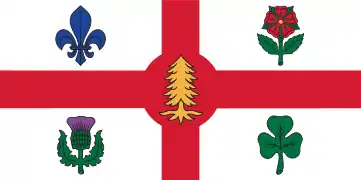Service de police de la Ville de Montréal
The Service de police de la Ville de Montréal (SPVM) (French for City of Montreal Police Service) is the municipal police service for the city of Montreal, Quebec, Canada and the neighbouring communities in the urban agglomeration of Montreal. With about 4,600 officers and 1,600 civilian staff, it is the second largest municipal police agency in Canada after the Toronto Police Service.
| City of Montreal Police Service Service de police de la Ville de Montréal | |
|---|---|
 | |
| Abbreviation | SPVM |
| Agency overview | |
| Formed | March 15, 1843 |
| Annual budget | C$587 million (2014) |
| Jurisdictional structure | |
| Size | 430.5 square kilometres (166.2 sq mi) |
| Operational structure | |
| Headquarters | 1441 Saint Urbain Street, Montreal, Quebec, Canada |
| Sworn members | 4,562 (2019)[1] |
| Unsworn members | 1,356 (2019)[1] |
| Elected officer responsible | |
| Agency executive |
|
| Facilities | |
| Stations | 33 |
| Road vehicles | 1,687 (2015) |
| Water vehicles | 23 (2015) |
| Dogs | 35 German Shepherds 7 Labradors |
| Website | |
| www.spvm.qc.ca/ | |
History
The Montreal Police Service was created on March 15, 1843. At that time, there were 51 police officers in Montreal. The first officers did not wear uniforms. In order to be recognizable as police officers by civilians, the first uniforms were created in 1848. In 1853, they won the right to carry firearms in the performance of their duties.
In the early twentieth century, the Montreal Police Service counted 467 constables, inspectors and managers. The force was subdivided, as squads of morality and local departments were created.
The size of the police force remained roughly the same from the beginning of the century until 1930, when it hired more staff in the context of the Wall Street Crash of 1929. During the Great Depression, tens of thousands of workers lost their jobs and there was an increase in crime. In the late 1930s, the Montreal Police Service had about 1,500 employees.
Following the progress of scientific analysis, a mobile laboratory was created in 1957. It evolved and changed in the 1980s to become the technical section.
The Museum of the Montreal Police (French: Musée de la police de Montréal) was established in 1992 to preserve the history of the Montreal Police Service.[2]
Chiefs of Police

The following is a list of the Chiefs and Directors of the Service de police de la Ville de Montréal.[3]
| No. | Name | Term start | Term end |
|---|---|---|---|
| 1. | Alexandre Comeau | 1843 | 1844 |
| 2. | Thomas Wiley | 1844 | 1849 |
| 3. | Hippolyte Jérémie | 1849 | 1850 |
| 4. | Thomas McGrath | 1850 | 1853 |
| 5. | Chas. O. Ermatinger | 1853 | 1854 |
| 6. | Moses Judah Hayes | 1854 | 1861 |
| 7. | Guillaume Lamothe | 1861 | 1865 |
| 8. | Fred A. Penton | 1865 | 1879 |
| 9. | Hercule Paradis | 1879 | 1888 |
| 10. | George A. Hughes | 1888 | 1900 |
| 11. | David Legault | 1901 | 1904 |
| 12. | Olivier Campeau | 1904 | 1918 |
| 13. | Joseph Tremblay (interim) | 1918 | 1918 |
| 14. | Pierre Bélanger | 1919 | 1928 |
| 15. | Hulbrit Langevin | 1928 | 1931 |
| 16. | Fernand Dufresne | 1931 | 1946 |
| 17. | Charles Barnes (interim) | 1947 | 1947 |
| 18. | Albert Langlois | 1947 | 1954 |
| 19. | T.O. Leggett (interim) | 1954 | 1956 |
| 20. | Pacifique Plante (interim) | 1956 | 1956 |
| 21. | Albert Langlois | 1957 | 1961 |
| 22. | Ernest Pleau (interim) | 1961 | 1961 |
| 23. | Adrien J. Robert | 1961 | 1965 |
| 24. | Jean-Paul Gilbert | 1965 | 1970 |
| 25. | Marcel Saint-Aubin | 1970 | 1971 |
| 26. | Jean-Jacques Saulnier | 1971 | 1971 |
| 27. | Maurice Saint-Pierre (interim) | 1972 | 1972 |
| 28. | René Daigneault | 1972 | 1977 |
| 29. | Henri-Paul Vignola | 1977 | 1981 |
| 30. | André De Luca | 1982 | 1985[4] |
| 31. | Roland Bourget | 1985 | 1989[5] |
| 32. | Alain Saint-Germain | 1989 | 1994 |
| 33. | Jacques Duchesneau | 1994 | 1998 |
| 34. | Claude Rochon (interim) | 1998 | 1998 |
| 35. | Michel Sarrazin | 1998 | 2005 |
| 36. | Yvan Delorme | 2005 | 2010 |
| 37. | Marc Parent | 2010 | 2015 |
| 38. | Philippe Pichet | 2015 | 2017 |
| 39. | Martin Prud'homme[6] | 2017 | 2018 (one year interim period) |
| 40. | Sylvain Caron | 2018 | Present |
Organization
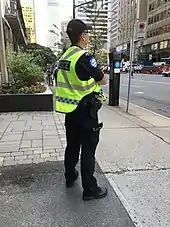
The force is led by Director of Police Sylvain Caron,[7] formerly deputy director-general of Sûreté du Québec.[8]
The rank structure and strength of the force as of 2019 was:
- Director (1): three gold fleur-de-lis under crest over a crossed gold sword and baton; similar to the insignia of a lieutenant-general in the Canadian Army
- Assistant Director (6): two gold fleur-de-lis under crest over a crossed gold sword and baton; similar to the insignia of a major-general in the Canadian Army
- Chief Inspector (15): four gold stripes; former insignia of a colonel in the Canadian Army
- Inspector (25): three gold stripes; former insignia of a lieutenant-colonel in the Canadian Army
- Commandant (68): two and-a-half gold stripes; former insignia of a major in the Canadian Army
- Lieutenant (47) and Detective Lieutenant (76): one and a-half gold stripes; former insignia of a lieutenant in the Canadian Army
- Sergeant (365) and Detective Sergeant (641): half gold stripe
- Constable (3,318)[1]
Some of the police functions carried out by the service, include:
- Patrol police officers
- Intervention officers (GI, Riot police)
- Tactical response officers (SWAT)
- Motorcycle officers
- Community relations officers
- Physical surveillance officers (shadowing)
- Section chiefs
- Investigators
- K-9 unit officers
- Mounted patrol officers
- Marine patrol officers
- Patrol supervisors
- Parking enforcement officers
SPVM also has about 1,000 civilian employees, as well as about 200 police cadets.
Ranks
- Executive Officers
- Director (Directeur)
- Associate Director (Directeur-Adjoint)
- Staff Officers
- Chief Inspector (Inspecteur-chef)
- Inspector (Inspecteur)
- Commander (Commandant)
- Superior Officers
- Lieutenant (Lieutenant)
- Officers
- Constables
- Senior Constable (Agent Sénior)
- Constable (Agent)
Source:[9]
Operations
The SPVM covers an area of about 496 square kilometres and 1,958,000 residents of the island of Montreal.
There are 33 police stations that operate within four geographical regions: East, West, North and South.
Other units of the SPVM, include:
- K-9 section
- Mounted unit
- Nautical patrol
- Crisis management
- Strategic planning
- Emergency Response Team (SWAT)
- Forensics
- Airport Unit at Montréal–Pierre Elliott Trudeau International Airport
Fleet
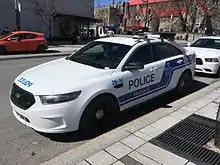
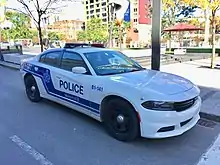
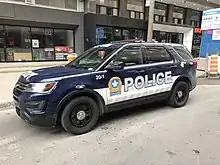
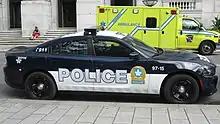
- Chevrolet Impala 9C1
- Dodge Charger Enforcer
- Ford Police Interceptor Sedan
- Ford Police Interceptor Utility
- Chevrolet Tahoe PPV
- Mitsubishi i-MiEV
- BMW R1200RT
- Harley-Davidson Electra-Glide
- Ford E-450
- Ford F-150
- Ford F-450 Super Duty
- Ford Escape
- Dodge Grand Caravan
- RAM 2500 Heavy Duty
- RAM 3500 Heavy Duty
- RAM Promaster
- Mercedes-Benz Sprinter
- Grumman Kurbmaster
- Freightliner M2-106
- Thunder-1 (armoured vehicle)
Equipment
The standard sidearm of the Montreal Police is the Glock 19.[10] Remington 870 shotguns and FN P90 sub-machine guns are also stocked by the SPVM and its Emergency Response Team armory, but these long guns are rarely used.
Prior to the Glock 19 officers carried the Walther P99 9mm as the sidearm which replaced the .357 Magnum revolvers in the early 2000s.
Criticism

On 3 November 2005, the United Nations Human Rights Committee advised the Canadian government to allow an enquiry on the SPVM about its mass arrests tactic during political demonstrations.[11][12][13][14] The tactic is a rapid encirclement of as many protesters as possible regardless of how they may have conducted themselves during the demonstration, and is argued to be a violation of their fundamental rights.[15] According to Francis Dupuis-Déri, a political science professor at Université du Québec à Montréal, police officers employ this tactic because of a "deviance" radical political demonstrators pose to media, politicians and police officers themselves.[16] The SPVM was once again criticized in the aftermath of the August 10, 2008 riots, which started due to the shooting death of 18-year-old immigrant Fredy Alberto Villanueva by an officer who alleged that Villanueva was attacking him and his partner while they were arresting Villanueva's older brother. He argued that he was trying to save his partner and himself by firing his Walther P99 service gun on 18-year-old Fredy Villanueva.[17]
In 2012, the SPVM also came under criticism regarding their handling of the 2012 Quebec student protests.[18]
Former Montreal police officer Stéfanie Trudeau was given a 12-month suspended sentence and ordered to do 60 hours of community service for assaulting a man in October 2012. Trudeau, known as "Officer 728" for her badge number, was found guilty of assault in February 2016 for using excessive force when arresting Serge Lavoie outside his home. Quebec Court Judge Daniel Bédard said Trudeau was the instigator in the illegal arrest, and the situation escalated because of her conduct. He noted that Lavoie did not pose a threat to Trudeau and her patrol partner.[19]
In June 2016, the Quebec Minister of Public Security introduced an independent agency, the "Bureau des enquêtes indépendantes (BEI)", to be responsible for investigating "shootings, serious injuries and deaths stemming from police interventions".[20] The selection of investigators was immediately and widely criticized for being composed of former members law enforcement.[21] Eleven out of the eighteen members are former police officers,[22] in addition to being "nearly 100 percent white and composed almost entirely of men".[22] Furthermore, the structure of the agency itself was criticized for lacking independent powers, since the BEI "acts only at the request of the Minister of Public Security".[22][23]
See also
References
- "Demographic statistics about SPVM personnel" (PDF). SPVM. 25 September 2020. Retrieved 3 January 2021.
- "Musée de la police: About the Museum". Service de Police de la Ville de Montréal. Retrieved 26 December 2012.
- "Chefs/Directeurs de police de la Ville de Montréal" (PDF). Service de police de la Ville de Montréal. Retrieved 10 February 2014.
- Johnston, David (1985-02-02). "Strife between top Montreal cops as Bourget takes over as chief of force". The Gazette (Montreal). Retrieved 15 November 2012.
- "Roland Bourget est décédé". Agence QMI. 2010-09-13. Retrieved 15 November 2012.
- "Interim Montreal police chief Martin Prud'homme ready to lead change". "Global News". 2017. Retrieved 2018-02-04.
- "Sylvain Caron chosen as new Montreal police chief". Montreal Gazette.
- "Montreal chooses Sylvain Caron as new police chief". cbc.ca. Canadian Broadcasting Corporation.
- "Insignes et grades." SPVM. Retrieved 2020-04-04.
- http://www.lapresse.ca/actualites/montreal/201408/29/01-4795821-de-nouveaux-pistolets-pour-le-spvm.php
- "L'ONU interpelle le Canada, responsable de plusieurs violations des droits et libertés". "Ligue des droits et libertés". 2005-11-03. Retrieved 2009-05-05.
- "L'ONU se penche sur les méthodes du SPVM". "LCN". 2005-11-03. Retrieved 2009-05-05.
- "Montreal police reprimanded by UN". "The Hour". 2005-11-10. Archived from the original on 2007-09-27. Retrieved 2009-05-05.
- "Arrested victory". "The Mirror". 2007-06-13. Retrieved 2009-05-05.
- "L'ONU blâme la police de Montréal". "Le Couac". 2006. Retrieved 2009-05-05.
- Dupuis-Déri, Francis. "Broyer du noir: manifestations et répression policière au Québec", Les ateliers de l'éthique vol. 1, num. 1, printemps 2006,. p. 59-80
- "Family 'destroyed' by death of Montreal man shot by police". CBC News. 2008-08-15.
- "I'm Not a Quebec Protester, But Police Assaulted Me Anyway". "Huffington Post". 2012. Retrieved 2012-05-28.
- http://www.cbc.ca/news/canada/montreal/officer-728-assault-sentence-1.3600799
- "Quebec's independent investigation unit called out for lack of diversity". Retrieved 2016-07-14.
- "L'autonomie du BEI est remise en question". Retrieved 2016-07-14.
- "Ex-cops dominate new agency that investigates police shootings". 2016-06-28. Retrieved 2016-07-14.
- "Mandate and Powers - Bureau des enquêtes indépendantes". www.bei.gouv.qc.ca. Retrieved 2016-07-14.
